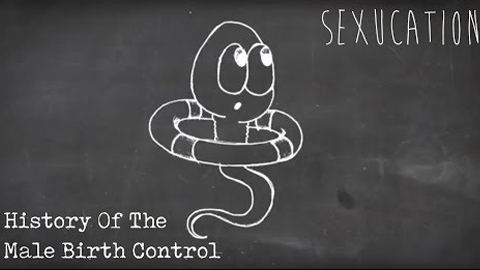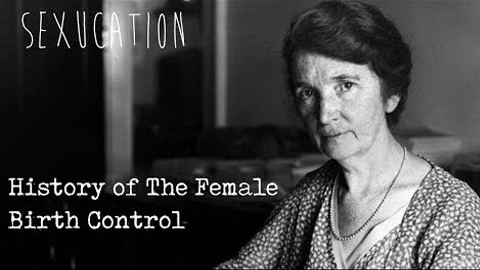Historically,
the burden of the consequences of sexual relations between men and women
has always been laid on the woman.
Men were encouraged to sow a few wild oats
while women were regarded as passive partners who found no pleasure in sex.
And God forbid, if women showed signs of experiencing sexual pleasure.
They were regarded as devious and even accused of witchcraft.
As expected, one of the most common side effects of sexual relations is pregnancy,
and with no birth control available,
women were forced to either carry out a pregnancy with often physical and financial hardship
or get a back alley abortion or hysterectomy
with harmful consequences to their health, often leading to death,
and infanticide was common before birth control.
The quest for birth control was led by Margaret Sanger,
whose mother endured 18 pregnancies
and who as a nurse saw the hardship of pregnancies of working class women firsthand.
Margaret Sanger opened the first birth control clinic in 1916 in Brownsville, Brooklyn,
to spread information about her work.
She published her newsletter, The Woman Rebel.
From Volume 1 Number 4, June 1914:
A woman’s body belongs to herself alone.
It is her body.
It does not belong to the church.
It does not belong to the United States of America or to any other government on the face of the Earth.
The first step towards getting life, liberty and the pursuit of happiness
for any woman
is her decision whether or not she shall become a mother.
The woman rebel was deemed obscene literature,
according to the Comstock Law,
which also prohibited the distribution of contraceptives.
Margaret Sanger was arrested and found guilty of maintaining a public nuisance
and sentenced to 30 days in jail.
When released, she reopened the clinic and persevered through more arrests and prosecutions.
Margaret Sanger’s controversial support of eugenics, the control of population growth
and the improvement of the human race
manifested in the belief that the feeble-minded
and those with transmissible congenital disease should be sterilized.
In fact, the United States had several sterilization programs at that time.
Her eugenics mission, however, seems to stem from the desire
to not have children grow up in poverty with no future,
rather than from a racist agenda.
Well, I think the greatest sin in the world is bringing children into the world
that have disease from their parents
that have no chance in the world to be a human being, practically.
Delinquents, prisoners, all such a thing, just marked when they’re born.
That, to me, is the greatest sin that people can commit.
And Martin Luther King Jr had this to say about her.
There is a striking kinship between our movement and Margaret Sanger’s early efforts.
She, like we saw the horrifying conditions of ghetto life.
Like we, she knew that all of society is poisoned by cancerous slums.
Like we, she was a direct actionist. A nonviolent resister.
In 1921, Margaret Sanger founded the American Birth Control League,
the precursor to the Planned Parenthood Federation.
In 1951, Sanger persuaded Gregory Pincus,
an endocrinologist who had achieved in-vitro fertilization in rabbits
to work on a birth control pill.
Katharine McCormick, heiress to a great fortune with a degree and interest in biology,
provided most of the money for the research.
McCormick was a women’s activist and suffragette
who even helped Sanger by smuggling diaphragms into the country.
Since contraception was illegal in the U.S. at the time,
clinical trials were conducted in Puerto Rico.
But when large numbers of women dropped out of the study due to the severe side effects
the pill was given to women locked up in a Massachusetts insane asylum without their consent
or informing them of the nature or side effects of the pill.
Eventually, it was decided to actually tell Puerto Rican women what the pill was for,
and they signed up by the hundreds,
but they still weren’t told that they were part of a clinical trial or that the pill was experimental.
The study deemed the pill effective.
However, 17% of participants suffered from side effects
such as nausea, dizziness, headaches, stomach pain and vomiting.
In 1960, the FDA approved Enovid, the first female birth control pill
with the same side effects as in the clinical trials.
Enovid contained ten times the amount of hormones necessary for effective contraception
and side effects were not disclosed to women.
In the 1965 Supreme Court case, Griswold versus Connecticut,
the court ruled that the private use of contraceptives was a constitutional right,
thus putting an end to the Comstock Law.
The pills hormone levels were only reduced as a result of the Nelson Pill Hearings in 1970.
100 word insert on the potential side effects was mandated to be added
to every package of the pill.
At the hearings, Alice Wolfson, a women’s activist in the audience,
jumped up and asked,
‘Why is there no pill for men?’
No women were asked to testify at these hearings.
Today, we ridicule the endless list of side effects in medical commercials,
but only the struggle to disclose the side effects of the birth control pill
gave people the right to know what side effects medications cause.
It also led to the consent requirements medical studies must abide by today.
But most importantly, the pill give women control over their fertility
and the choice over when and if to have children.
This was a prerequisite for the path to equality for women at the workplace
and also enabled the sexual revolution of the 1960s and 70s.
It allowed women to have sex for pleasure without the fear of pregnancy.
Legally, women couldn’t refuse sex with their spouse until 1993.
So now is the time to even the playing field
and put our efforts into bringing a form of male contraceptive pill to the market.








